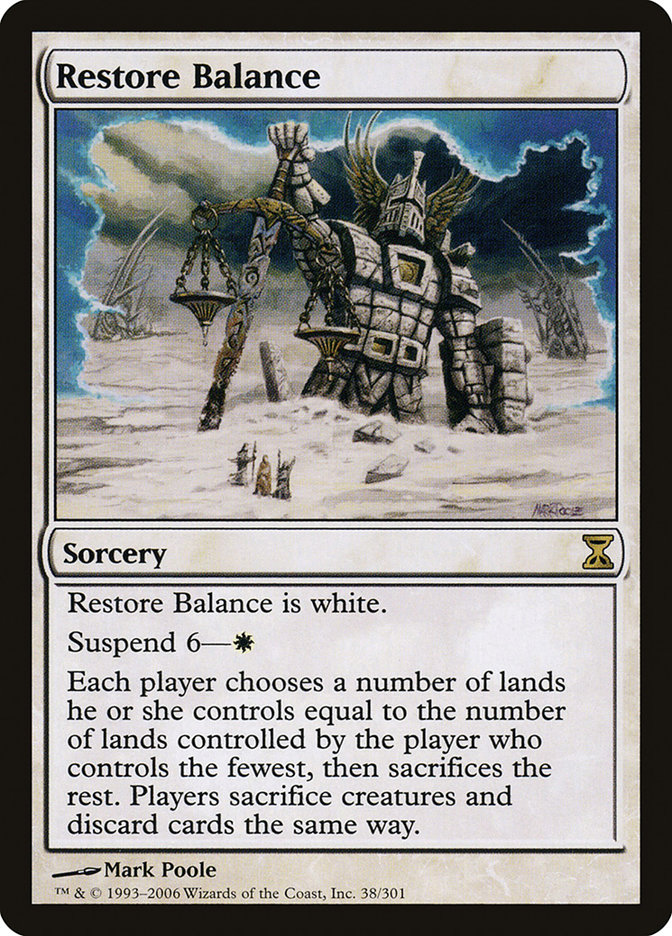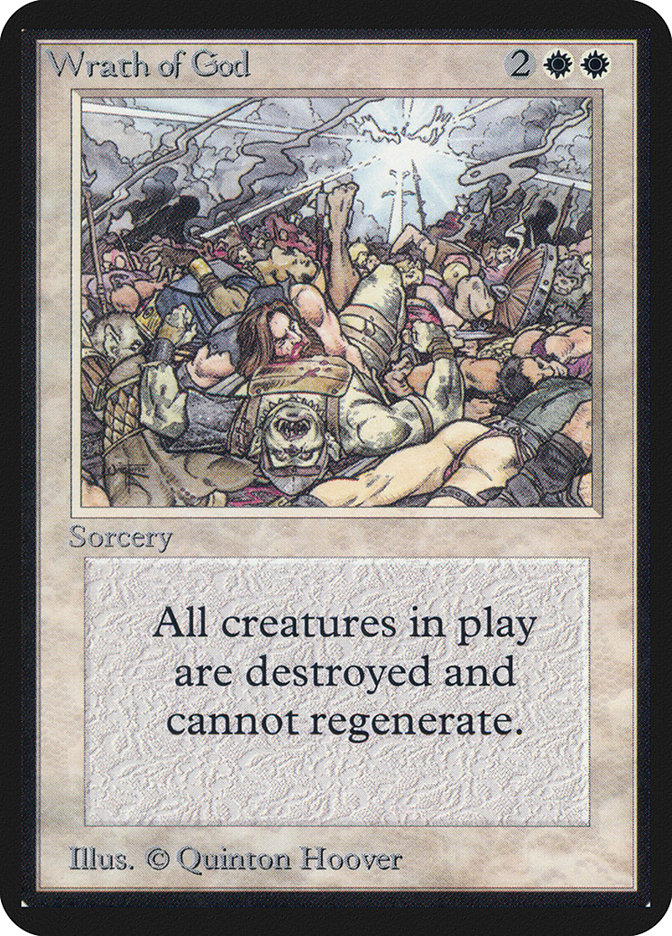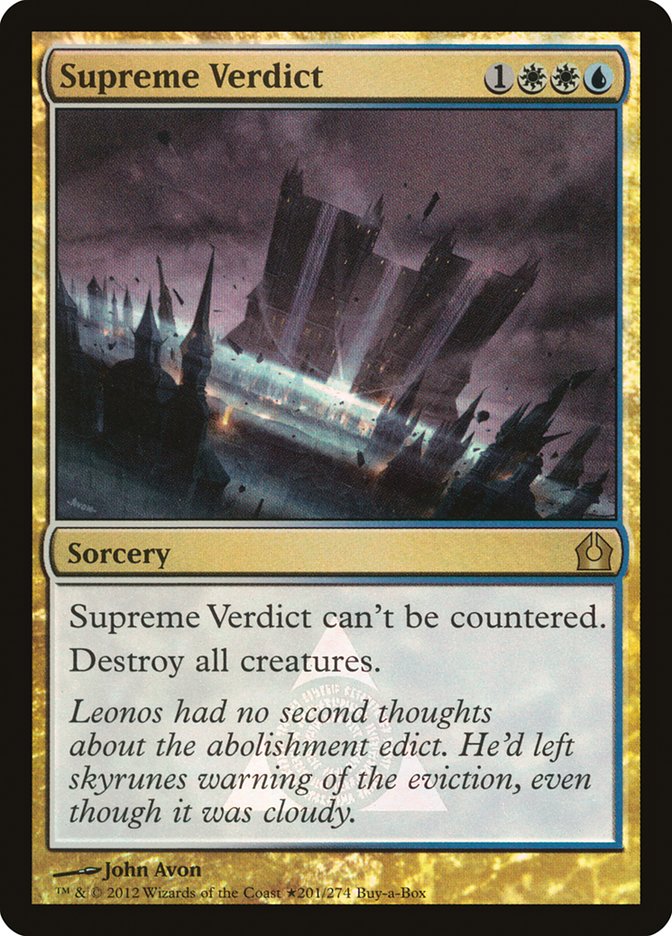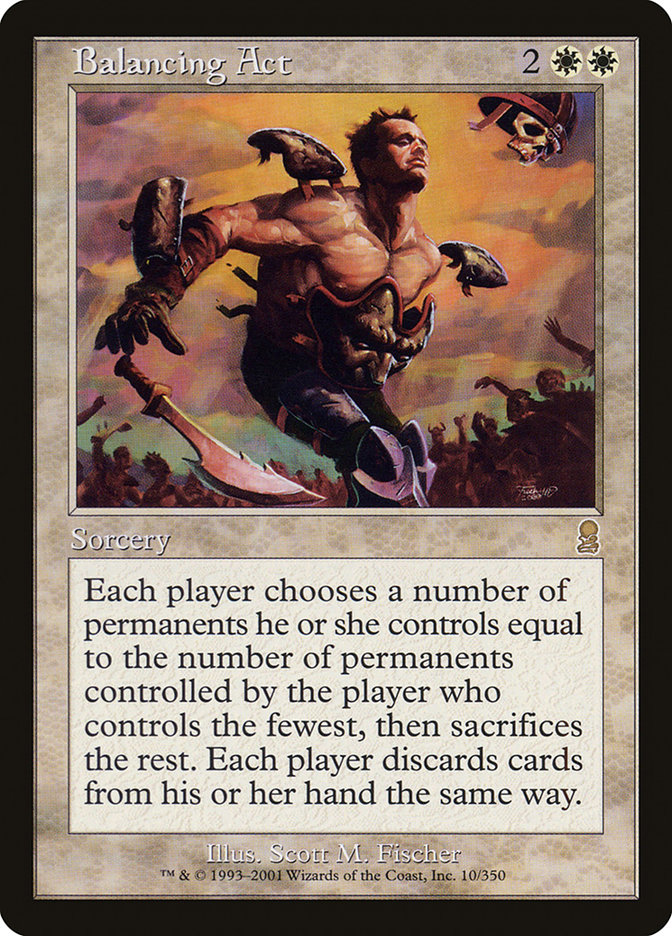Restore Balance MTG Card
| Card sets | Released in 2 setsSee all |
| Rarity | Rare |
| Type | Sorcery |
| Abilities | Suspend |
Text of card
Restore Balance is white. Suspend 6— Each player chooses a number of lands he or she controls equal to the number of lands controlled by the player who controls the fewest, then sacrifices the rest. Players sacrifice creatures and discard cards the same way.
Cards like Restore Balance
Restore Balance is a unique spell whose impact can be as dramatic as its name implies. Evocative of the more traditional board wipes like Wrath of God or Supreme Verdict, what sets Restore Balance apart is its method of leveling the playing field by forcing each player to match the number of lands, creatures, and cards in hand with the player who has the fewest. Similarly, Balancing Act operates on this principle of parity, but without Restore Balance’s suspend mechanic, which allows a delayed cast without paying its mana cost.
In the realm of balanced effects, we observe Cataclysm, a card that also imposes strict limitations on players’ resources but can be cast outright for its mana cost. Cataclysm guarantees that players keep only one creature, land, enchantment, and artifact, offering a more predictable outcome. However, Restore Balance can be cast for free with its suspend mechanic, potentially leaving opponents unprepared for such a disruptive play.
As we compare these alternatives, Restore Balance emerges as a strategic powerhouse in MTG. Its unique cost and delayed trigger make it a formidable inclusion in any deck built around exploiting such symmetry-based effects.
Cards similar to Restore Balance by color, type and mana cost
Decks using this card
MTG decks using Restore Balance. Dig deeper into the strategy of decks, sideboard cards, list ideas and export to play in ARENA or MOL.
| # | Name | Format | Archetype | Event |
|---|---|---|---|---|
 | Electrobalance | Modern | Electrobalance | Modern Challenge 32 2024-04-13 |
 | Electro Rhinos | Modern | Electro Rhinos | Modern League 2024-02-06 |
 | WUBR | Modern | Modern Showcase Challenge 2024-02-10 | |
 | Four-color Combo | Modern | Electro Rhinos | Eternal Weekend Europe 2023 Modern Mainevent |
Card Pros
Card Advantage: Restore Balance challenges the playfield by evening out the number of lands and cards in hand, potentially stripping opponents of significant resources while retaining a balanced state for the player who casts it. This can create a powerful swing in control of the game, translating into a massive card advantage.
Resource Acceleration: While Restore Balance does not directly accelerate resources, it fundamentally shifts the game’s momentum by resetting resource levels. Clever deck construction can allow the player to break the symmetry of Restore Balance, rapidly rebuilding their board state and gaining an insurmountable lead.
Instant Speed: Although Restore Balance is a sorcery, it can be deployed at instant speed through various MTG mechanics such as cascade, allowing for surprise shifts in the game state at critical moments. This surprise factor can catch opponents off guard, disrupt their strategies, and secure a favorable position for the player casting Restore Balance.
Card Cons
Discard Requirement: One of the hurdles to overcome when playing Restore Balance is the necessity to discard cards. This can often result in a negative card advantage, especially if your hand is already dwindling. Having to let go of potentially crucial cards can backfire, leaving you at a disadvantage in the long game.
Specific Mana Cost: Restore Balance demands a particular blend of mana to be cast. Its White mana cost requires a commitment to that color, which may not synergize seamlessly with all deck types. Decks that don’t naturally lean towards White mana might find this card challenging to weave into their strategy without compromising their mana base.
Comparatively High Mana Cost: While Restore Balance has the potential to alter the state of the game dramatically, its casting cost is on the higher side when juxtaposed with other board-altering spells. This mana investment must be considered, particularly in games where tempo plays a pivotal role. Players may find other options to be more cost-effective while achieving similar outcomes.
Reasons to Include in Your Collection
Versatility: Restore Balance adapts to various deck archetypes, especially those that focus on controlling the board state. Its ability to clear the battlefield and equalize the game can be critical during tight matches.
Combo Potential: This card opens the door for numerous synergies, particularly with cascade strategies or cards that allow you to bypass its casting cost. It can be a game-changer in decks designed to manipulate hand and land advantages.
Meta-Relevance: Given the fluctuating nature of the competitive scene, Restore Balance holds a valuable position in formats where establishing and disrupting the equilibrium is crucial. It can dismantle your opponent’s progress and swing the momentum in your favor.
How to beat
Restore Balance is a potent spell in Magic: The Gathering with the ability to turn the tides of a game by equalizing the number of lands, creatures, and cards in each player’s hand. Overcoming this card requires a strategy that hinges on asymmetry and timing. First, holding onto cards in hand can be crucial since Restore Balance will force each player to discard down to the number of cards held by the player with the fewest. Playing out your lands and creatures only when necessary will mitigate the potential damage done by Restore Balance.
Moreover, employing cards that can’t be easily swept away or that generate value upon leaving the battlefield can significantly lessen the impact. Consider cards like tokens that can be produced in large quantities or creatures with undying or persist that return to the battlefield after dying. This will help you maintain a board presence. Also, instant-speed interaction is key, allowing you to respond to Restore Balance being cast, whether that’s counter magic or effects that can sacrifice your own permanents for an advantage. Denying resources or minimizing the symmetry Restore Balance aims for will give you a competitive edge against this challenging card.
Ultimately, playing smart and maintaining resource flexibility will prove essential when navigating the unique challenge posed by Restore Balance in your Magic: The Gathering encounters.
Where to buy
If you're looking to purchase Restore Balance MTG card by a specific set like Time Spiral and Time Spiral Remastered, there are several reliable options to consider. One of the primary sources is your local game store, where you can often find booster packs, individual cards, and preconstructed decks from current and some past sets. They often offer the added benefit of a community where you can trade with other players.
For a broader inventory, particularly of older sets, online marketplaces like TCGPlayer, Card Kingdom and Card Market offer extensive selections and allow you to search for cards from specific sets. Larger e-commerce platforms like eBay and Amazon also have listings from various sellers, which can be a good place to look for sealed product and rare finds.
Additionally, Magic’s official site often has a store locator and retailer lists for finding Wizards of the Coast licensed products. Remember to check for authenticity and the condition of the cards when purchasing, especially from individual sellers on larger marketplaces.
Below is a list of some store websites where you can buy the Restore Balance and other MTG cards:
 BUY NOW
BUY NOW BurnMana is an official partner of TCGPlayer
- eBay
- Card Kingdom
- Card Market
- Star City Games
- CoolStuffInc
- MTG Mint Card
- Hareruya
- Troll and Toad
- ABU Games
- Card Hoarder Magic Online
- MTGO Traders Magic Online
See MTG Products
Printings
The Restore Balance Magic the Gathering card was released in 2 different sets between 2006-10-06 and 2021-03-19. Illustrated by Mark Poole.
| # | Released | Name | Code | Symbol | Number | Frame | Layout | Border | Artist |
|---|---|---|---|---|---|---|---|---|---|
| 1 | 2006-10-06 | Time Spiral | TSP | 38 | 2003 | Normal | Black | Mark Poole | |
| 2 | 2021-03-19 | Time Spiral Remastered | TSR | 36 | 2015 | Normal | Black | Mark Poole |
Legalities
Magic the Gathering formats where Restore Balance has restrictions
| Format | Legality |
|---|---|
| Commander | Legal |
| Legacy | Legal |
| Modern | Legal |
| Oathbreaker | Legal |
| Vintage | Legal |
| Duel | Legal |
| Predh | Legal |
| Penny | Legal |
Rules and information
The reference guide for Magic: The Gathering Restore Balance card rulings provides official rulings, any errata issued, as well as a record of all the functional modifications that have occurred.
| Date | Text |
|---|---|
| 2013-06-07 | Although originally printed with a characteristic-defining ability that defined its color, this card now has a color indicator. This color indicator can’t be affected by text-changing effects (such as the one created by Crystal Spray), although color-changing effects can still overwrite it. |
| 2021-03-19 | Any abilities of the creatures sacrificed may modify or trigger on the lands being sacrificed, but won’t modify or trigger on the cards being discarded. Abilities of the sacrificed lands won’t modify or trigger on the creatures being sacrificed or the cards being discarded. |
| 2021-03-19 | Any abilities that trigger during this process will wait to be put onto the stack until Restore Balance is done resolving. |
| 2021-03-19 | As Restore Balance resolves, first the player whose turn it is chooses the appropriate number of lands they control, then each other player in turn order does the same knowing the choices made before them. Then all the lands that weren’t chosen are sacrificed at the same time. Then, starting with the player whose turn it is again, each player chooses the appropriate number of creatures they control, then sacrifice their other creatures after all choices have been made. Finally, players choose cards in hand without revealing them in the same order and discard the remaining cards. |
| 2021-06-18 | A card with no mana cost can’t be cast normally; you’ll need a way to cast it for an alternative cost or without paying its mana cost, such as by suspending it. |
| 2021-06-18 | As the second triggered ability resolves, you must cast the card if able. You must do so even if it requires targets and the only legal targets are ones that you really don’t want to target. Timing permissions based on the card’s type are ignored. |
| 2021-06-18 | Cards exiled with suspend are exiled face up. |
| 2021-06-18 | Exiling a card with suspend isn’t casting that card. This action doesn’t use the stack and can’t be responded to. |
| 2021-06-18 | If a card with no mana cost is given an alternative cost equal to its mana cost (by Snapcaster Mage, for example), that cost cannot be paid and the card cannot be cast this way. |
| 2021-06-18 | If an effect refers to a “suspended card,” that means a card that (1) has suspend, (2) is in exile, and (3) has one or more time counters on it. |
| 2021-06-18 | If the card has in its mana cost, you must choose 0 as the value of X when casting it without paying its mana cost. |
| 2021-06-18 | If the first triggered ability of suspend (the one that removes time counters) is countered, no time counter is removed. The ability will trigger again at the beginning of the card’s owner’s next upkeep. |
| 2021-06-18 | If the second triggered ability is countered, the card can’t be cast. It remains exiled with no time counters on it, and it’s no longer suspended. |
| 2021-06-18 | If the spell requires any targets, those targets are chosen when the spell is finally cast, not when it’s exiled. |
| 2021-06-18 | If you can’t cast the card, perhaps because there are no legal targets available, it remains exiled with no time counters on it, and it’s no longer suspended. |
| 2021-06-18 | If you cast a card “without paying its mana cost,” such as with suspend, you can’t choose to cast it for any alternative costs. You can, however, pay additional costs. If the card has any mandatory additional costs, you must pay those if you want to cast the card. |
| 2021-06-18 | Suspend is a keyword that represents three abilities. The first is a static ability that allows you to exile the card from your hand with the specified number of time counters (the number before the dash) on it by paying its suspend cost (listed after the dash). The second is a triggered ability that removes a time counter from the suspended card at the beginning of each of your upkeeps. The third is a triggered ability that causes you to cast the card when the last time counter is removed. If you cast a creature spell this way, it gains haste until you lose control of that creature (or, in rare cases, you lose control of the creature spell while it’s on the stack). |
| 2021-06-18 | The mana value of a spell cast without paying its mana cost is determined by its mana cost, even though that cost wasn’t paid. |
| 2021-06-18 | When the last time counter is removed, the second triggered ability of suspend (the one that lets you cast the card) triggers. It doesn’t matter why the last time counter was removed or what effect removed it. |
| 2021-06-18 | You are never forced to activate mana abilities to pay costs, so if there is a mandatory additional mana cost (such as from Thalia, Guardian of Thraben), you can decline to activate mana abilities to pay for it and hence fail to cast the suspended card, leaving it in exile. |
| 2021-06-18 | You can exile a card in your hand using suspend any time you could cast that card. Consider its card type, any effects that modify when you could cast it (such as flash) and any other effects that stop you from casting it (such as from Meddling Mage’s ability) to determine if and when you can do this. Whether you could actually complete all steps in casting the card is irrelevant. For example, you can exile a card with suspend that has no mana cost or that requires a target even if no legal targets are available at that time. |






